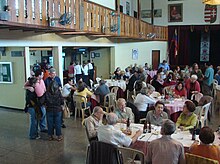Hungarian Venezuelan

Hungarian Cultural House in Caracas
|
|
| Regions with significant populations | |
|---|---|
| Greater Caracas | |
| Languages | |
| Venezuelan Spanish, Hungarian | |
| Religion | |
| Mostly Protestantism, Catholicism and Judaism | |
| Related ethnic groups | |
| Venezuelan of European descent |
The Hungarian-Venezuelan community is primarily composed of immigrants who left Hungary after World War II and the Hungarian Revolution of 1956. Although settled as immigrants in the second half of the 20th century, records of previous centuries prove there were Hungarians who visited Venezuela motivated by exploratory interests. Such is the case of the noble Hungarian expeditionary Pál Rosti, who traveled to the country in 1857 and photographed the region of San Juan de los Morros.
Most Hungarian immigrants arrived from Europe in 1946, and soon began meeting in Caracas, initially in private homes and later they were in a small rented house in neighborhood of "Los Chorros" in Caracas.
Hungarian Protestant community (mostly Calvinist and Lutheran) then began meeting to read the Holy Scriptures, and to celebrate religious ceremonies since December 24 of 1948, when Dr. Paul Puky started such ceremonies in a camp called "El Trompillo", with 30 Hungarians. Afterwards, Protestants Hungarians continued to organize until in 1954, they built a church on their own in La Castellana district, together with the German, Latvian and Scandinavian Protestant communities.
In the decade of the 50's many important personalities, began to found the institutional and traditional bases of the community. In 1953 at the initiative of Mrs. Egyed Erzsébet, the first Fehérbál was performed, which were presented to the young Hungarian society, becoming a tradition that still exists to this day.
On the other hand, military commander Andrew Farkas and Géza Dolányi, were along with other members of the colony founders, the founders in 1954 of the "Mindszenty's Roman Catholic ecclesial community". Subsequently, Farkas was not only Catholic member of the council, but served as a mediator and peacemaker figure in the colony for decades.
Having grown more the diaspora, the Hungarians decided to acquire a larger land and build a cultural house, which could serve as headquarters for immigrants. The Venezuelan Social Hungarian Cultural Centre, known as "The Hungarian House" was opened in 1969, after the planning of architect Kornél Gyömrei. The foundation of the cultural center was initiated by initiative of Edit Kertész, who oversaw the construction of what became the largest House of Hungary in Latin America. Also it's one of the Hungarian houses artistically more elaborate, being a reference to the other colonies of Hungarian emigrants.
...
Wikipedia
